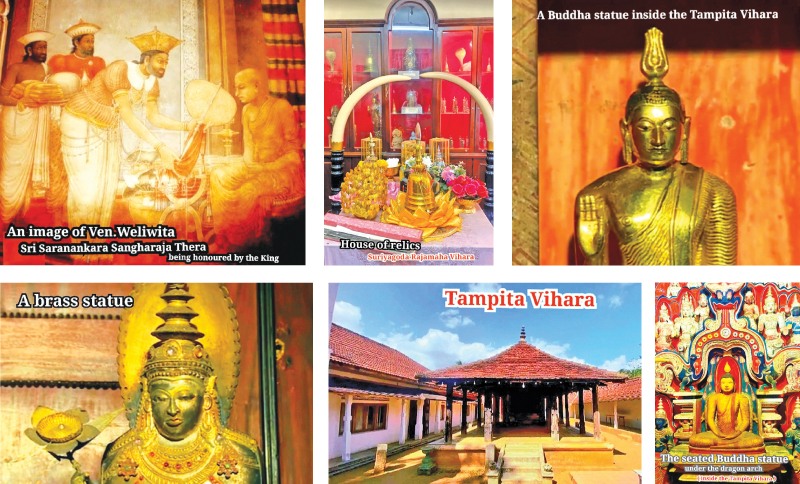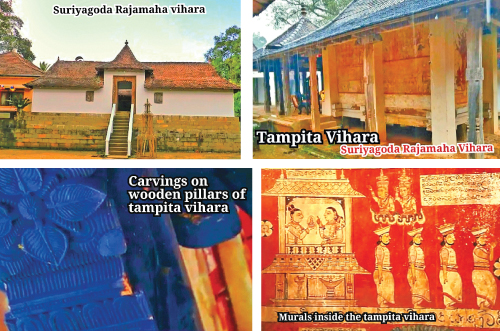A cornerstone of Buddhist renaissance-by S. K. Tissera Chilaw Group corr
Image Source:Sundayobserver
Source:Sundayobserver
Turning South from Kiribathkumbura on the Colombo-Kandy road and travelling on the Waturakumbura road, we enter an area where many historical stories are hidden. When we travel 1.5 km on the Waturakumbura road and turn right, we will find the path leading to the Suriyagoda temple. Today, the area is scattered with gardens of cloves, nutmeg and pepper.
The main reason for the village of Suriyagoda to become known among the people is the ancient Tampita temple. It still remains well-preserved in the historic Suriyagoda Raja Maha Vihara precincts where the most Ven. Weliwita Asaranasarana Sri Saranankara Sangharaja Thera, who was instrumental in bringing about a Buddhist renaissance in the hill country in particular, was ordained a bhikkhu. It is said that he lived there for over 30 years. The history of the temple dates back to the period of the Kotte Kingdom.
Image Source:Sundayobserver
It is believed that the Suriyagoda temple was first built by Suriyagoda Wijayasundara Seneviratne Wijekoon Rajakaruna Attanayaka Bandara, who was a teacher of King Parakramabahu VI (1410 AD- 1468 AD). An inscription reveals that construction work on the temple was carried out under the patronage of King Parakramabahu of Kotte.
The last Sinhala king of Kandy, Weera Parakkrama Narendrasinghe (1706 AD – 1739 AD), also renovated the temple and accordingly, it came to be known as Sri Narendraramaya too.
During the reign of King Wimaladharmasooriya II (1687 AD – 1707 AD), i.e. circa 1689, the long-lost Higher Ordination of bhikkhus was brought back from Burma and established here. Suriyagoda Kithsirimewan Rajakaruna Thera, who received Upasampada or Higher Ordination with the help and guidance of the Mahasangha of Siam at the Higher Ordination Ceremony held, was Ven. Weliwita Saranankara Thera’s teacher. Whoever goes to this historic temple can see many items used by Ven. Weliwita Saranankara Sangharaja Thera.
In the glass cabinets of the museum in the temple, we can see the palm leaf manuscripts used by the Sangharaja Thera, the copper-plate inscription he received from King Kirthi Sri Rajasinghe, the silver panhinda used by the Thera, his Thai saffron robe and several Dhamma scriptures used by him. Among the artefacts here is the most precious Buddha statue made of ivory, which belongs to the Kandyan era.
The tampita temple here is built on eight stone pillars, each of which is 2.5 feet tall. On them are wooden beams on whch the image house of wattle and daub has been built. This Buddha image house is 13 feet in length and eight feet in width. The main doorpost with animal motifs and flower motifs engraved is five feet tall.
The most impressive artefact in the tampita temple is the seated Buddha statue under the dragon arch (Makara Thorana), which is supposed to be the best of its kind in the Kandyan era. The artist of the murals and sculptures in the shrine room was none other than Deldeniye Siththara Naide,who was one of the best artists of the Kandy period. There are paintings on the outer walls of the tampita vihara, which was a tradition of the Kandyan period. These paintings depict scenes of hell. These paintings have been disfigured due to later plastering and whitewashing, but some of them have resurfaced as a result of archaeological conservation.
The ancient building supposed to have been used both as the pohoyageya and as the preaching hall is yet another architectural creation with eye-catching wooden pillars on which various designs of lotus and binara flowers and images of imaginary Berunda bird are engraved. Carvings such as coil of rope, dwarf figures, swans and angampora can also be seen.
This open building also attached to the tampita temple is surrounded by bhikkhus’ residences on three sides and in front of the structure is a stupa adding sanctity to the premises.









